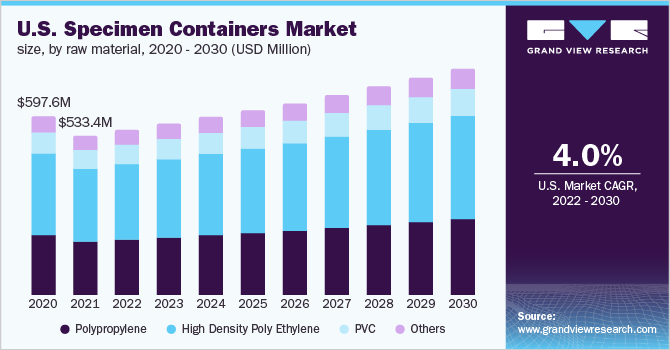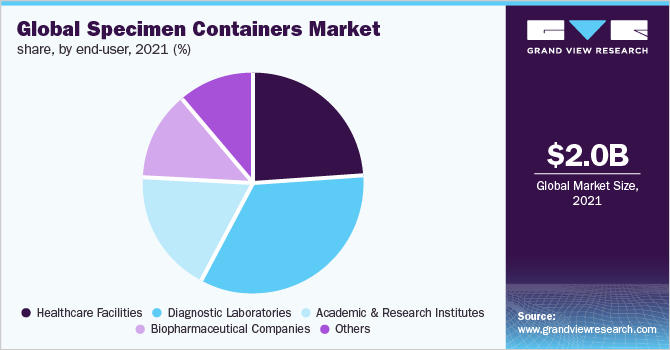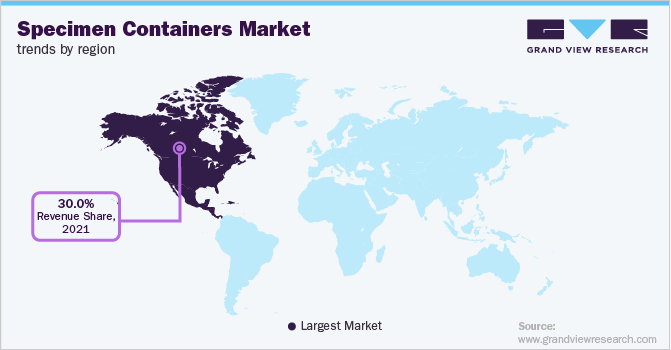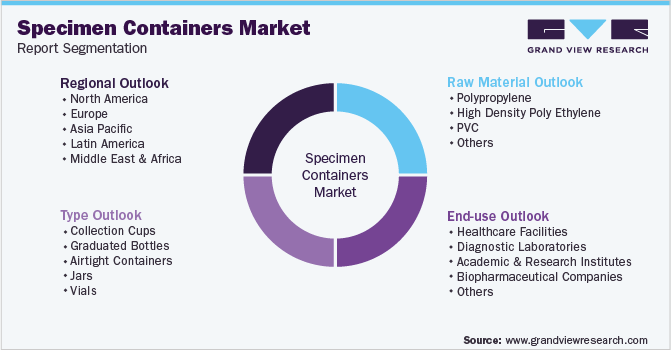- Home
- »
- Medical Devices
- »
-
Specimen Containers Market Size, Share Report, 2022 - 2030GVR Report cover
![Specimen Containers Market Size, Share & Trends Report]()
Specimen Containers Market Size, Share & Trends Analysis Report By Raw Material (Polypropylene, PVC), By Type (Airtight Containers, Vials), By End-user, By Region, And Segment Forecasts, 2022 - 2030
- Report ID: GVR-4-68039-986-2
- Number of Report Pages: 110
- Format: PDF, Horizon Databook
- Historical Range: 2018 - 2020
- Forecast Period: 2022 - 2030
- Industry: Healthcare
Report Overview
The global specimen containers market size was valued at USD 2.0 billion in 2021 and is expected to expand at a compound annual growth rate (CAGR) of 4.85% from 2022 to 2030. The major factors driving the market are increasing prevalence of chronic disease, the rising number of trauma cases and accidents, and technological advancements. Moreover, demand for specimen containers from diagnostic laboratories, academic and research institutes, healthcare facilities, and other end-use applications for the transport and collection of patient samples including sputum and urine will create significant opportunities in the near future.

Containers for collecting biological fluids such as urine, feces, mucus, and other specimens can be of any size, shape, or number. Fluids are often collected for testing at internal or external locations, such as a sterile testing room or a third-party hospital test site. Depending on the requirements of the facility or user, sample containers come in a wide range of choices, from cups to bottles, which is expected to spur industry growth.
Technological advancements such as universal containers for use in fields including molecular biology, genomics, and forensic science will drive the market. These types of containers are created in sterile, automated settings that have been independently verified to be free of DNase, RNase, human DNA, and pyrogen contamination. These containers are made specifically for handling priceless or dangerous samples in a safe manner while also preventing contamination and preserving the viability of the samples. These elements are crucial in molecular biology, forensics, and genomic research since any potential contamination could affect the findings of the analyses.
Therefore, laboratories are under increasing pressure to ensure safe, contamination-free handling of specimens due to the tremendous growth in these applications to support clinical diagnostic developments, which is anticipated to boost industry growth in the near future. For instance, in July 2017, new Sterilin containers from Thermo Fisher Scientific are released for use in molecular genomics, forensics, biology, and applications. Such improvements in specimen containers are anticipated to fuel industry expansion.
The demand for specific disposable containers is another important factor driving the market. Specific disposable containers have a number of advantages over reusable specimen containers. They are instant, simple to use, free of extraneous impurities that could affect the results of the analysis, and compliant with sanitary and epidemiological requirements. Medical plastics are perfect for single-use medical devices and surgical instruments. Discarding single-use instruments can dramatically reduce the danger of deadly infections and diseases. Medical products also utilize special plastics with antibacterial surfaces. Even if not regularly sterilized, antimicrobial surfaces are quite effective at both fending off and eliminating hazardous microorganisms. For instance, Staphylococcal infection rates are low due to the usage of sterile plastic containers, particularly disposable medical products including blood collection tubes, graded bottles, and sealed containers. Therefore, patients' risk of infection is reduced due to the increasing use of disposable plastic containers, which is anticipated to accelerate industry expansion in the near future.
With the spread of COVID-19, laboratories have been collecting more swab samples, which has changed patient demand for at-home sample collection services and raised awareness regarding the need for specimen collection containers. Globally, the COVID-19 epidemic has raised awareness regarding specimen collection containers. The market for specimen containers is predicted to benefit from an increase in coronavirus cases around the world. A typical technique for studying and identifying many diseases from samples, including the COVID-19 virus in the body, is the collection of patient samples from them, including urine and sputum. This pattern has fueled the industry expansion in terms of both value and volume sales. For instance, in August 2020, the official opening of Thermo Fisher Scientific's new manufacturing facility for COVID-19 sample collection products will drive the market in the near future.
Some of the other reasons that are projected to drive the product demand globally include the rising prevalence of urological illnesses, such as cystitis, urinary retention, kidney stones, urine incontinence, and benign prostatic hyperplasia, which causes bladder dysfunction. For instance, according to the National Health Service (NHS) in England, about 34% of women and about 61% of men suffer from disorders affecting the lower urinary tract. Furthermore, 200 million people globally are reportedly impacted by Urinary tract infection (UI), according to Phoenix Physical Therapy. Therefore, the need for specimen containers has increased due to the rising incidence of urological dysfunctions and associated procedures. Over the forecast period, this is anticipated to fuel market expansion.
The U.S. dominated the North American market in 2021. Government attempts to promote the adoption of disposable medical supplies in order to prevent infections in operating rooms are driving the market in the U.S. Increasing number of surgeries and the growing geriatric population are the other factors fueling the industry growth in the U.S. According to Regenexx, in the U.S., more than 7 million orthopedic surgeries are performed in 2021. Moreover, according to the National Center for Health Statistics, more than 40 million surgeries are performed in a year and are expected to grow exponentially. In addition, according to the American Psychological Association in 2021, the geriatric population in the country is currently at 46 million and is supposed to double itself by 2060, which is supposed to increase the number of surgeries. Moreover, advancements in technology are likely to drive the market for specimen containers.
Raw Material Insights
In 2021, the polypropylene segment captured the largest share of over 45.0%. High tensile strength, stain resistance, low moisture resistance, and resistance to a variety of chemical solvents, acids, and bases are just a few of the exceptional qualities of polypropylene, which is a lightweight material. It is widely used in packaging and labeling, construction, and the production of various laboratory equipment and other products because of its excellent chemical and mechanical qualities. The demand for polypropylene is anticipated to increase in the next years as a result of technical improvements and rising demand for the aforementioned components in a variety of end-use industries. Containers made of polypropylene work well for both liquid and solid samples.
The key players are focusing on the launch of innovative products, mergers and acquisitions, and regional expansion. For instance, in August 2021, FUJIAN JINYU NEW MATERIAL TECHNOLOGY signed a definitive agreement to be acquired by STERIMED for new high-end technical films for medical packaging and other industries. This technology makes it possible to generate thinner, highly tailored films with precise thickness control, generating in the most environmentally friendly manner possible. The PA-PP heat-resistant formable film and PA-PE formable barrier film are part of Jinyu's product line for medical device packaging. As a result of this, the market is expected to grow.
The PVC segment is expected to expand at the highest CAGR during the forecast period. Glass labware can be safer than plastic while maintaining accuracy. They come in a variety of shapes, sizes, and material compositions. Due to its adaptability, PVC is widely utilized in a variety of industrial, technical, and everyday applications, including the construction, transportation, packaging, electrical/electronic, and healthcare industries. Due to its unmatched performance qualities and cost-effectiveness, PVC has been utilized for hundreds of life-saving and healthcare products for almost 50 years in surgery, pharmaceuticals, medication delivery, and medical packaging.
Containers for intravenous solution delivery sets, containers for urinary continence and ostomy products, and others are typical examples of PVC healthcare products. PVC is a highly resilient and long-lasting material that may be utilized in a variety of applications. It is available in a variety of colors, including white, black, and many shades in between.
Type Insights
In 2021, the airtight containers segment held a dominant share of over 40.0%. Airtight containers avoid the spilling of the specimen and protect it from contamination. Airtight specimen containers are best suitable for the collection and transport of liquid specimens. Due to cheap manufacturing costs, easy access to raw materials, and the quick spread of technology, the market for airtight containers is highly fragmented. Several small- and medium-sized manufacturers now compete in local and regional markets. These regional producers also have an advantage in terms of the inexpensive availability of labor and raw resources. On the other hand, major global manufacturers have the resources to fund R&D initiatives that result in premium products. R&D activities in the market have consistently focused on finding new ways to use diverse combinations of raw materials to incrementally increase the strength of the specimen container and airtight lid, which is anticipated to boost segment growth.
The vials segment is expected to expand at the highest CAGR during the forecast period. In academic institutes, a lot of vials are utilized for research. There are several types of vials, including medium paddle vials, preservative vials, tubes, and empty vials. For storing specimens, empty vials are often made of polypropylene and feature leak-proof covers. Formaldehyde, formalin, ethanol, or isopropyl alcohol may be found in preservative vials, which are used to preserve clinical samples for longer periods of time. In hospitals and diagnostic facilities, urine samples are preserved using substances such as hydrochloric acid and boric acid. Recently, media paddle vials have been in use. They have a sterile growing substrate for microorganisms within. The medium should be preserved for incubation after being exposed to the specimen. The medium's expansion and color alterations might be used to interpret the results. Media paddle vials are simple to store and allow for quick clinical diagnosis, which is anticipated to increase segment growth.
For instance, in July 2017, to protect samples and ensure user safety, a new line of leakproof vials has been created that always allow the proper cap application. Thermo Scientific Clicktainer Samco vials' distinctive lock-lid design makes them perfect for the secure transportation of priceless and frequently dangerous research, clinical, and forensic samples. The brand-new Clicktainer Samco vials are made to safely collect and handle fluid, solid, and powder samples, including urine, sputum, and stool samples. They are in compliance with all relevant FDA rules and have the CE mark. As required by standards BS EN 14254 and 14401, they are additionally 95kPa leak and pressure tested to facilitate their use in hospital pneumatic transport systems.
End-user Insights
The diagnostic laboratories segment accounted for the largest share of more than 30.0% in 2021. Biological and chemical research has increased the demand for disposable products used in laboratories. A variety of testing techniques, research analogues, and innovative advances are carried out in laboratories, which have evolved into multipurpose research centers. Additionally, this has increased the need for laboratory supplies. In addition, over the past ten years, research-based studies have become more popular. This has caused new academic institutions to construct laboratories, which has increased the demand for laboratory disposables worldwide. For instance, in January 2021, the corporation purchased Groupe Novasep SAS's European viral vector production business with headquarters in Belgium for USD 830 million in net cash consideration. This acquisition was made within the laboratory products and biopharma services segment. The European viral vector manufacturing industry offers large biopharma customers and biotechnology firms manufacturing services for vaccines and treatments. The acquisition increases the segment's capacity for developing cell and gene therapies and vaccines.
To fulfill the rising demand in sectors including the biological sciences, food & beverages, and chemicals, research studies, and breakthroughs are multiplying quickly. Research in these industries comes to an end when a new product is put to the test at the lab scale before moving on to the manufacturing level. The above-mentioned industries are investing more in R&D to keep up with the growing demand for laboratory disposables and help businesses maintain their market expansion. Demand for laboratory disposable products is rising as a result of an increase in the number of clinical laboratory tests and life science research investigations. Additionally, throughout the projection period, an increase in the number of diagnostic and lab procedures and R&D activities would fuel market expansion globally.

The healthcare facilities segment is anticipated to witness the fastest growth over the forecast period. For a variety of applications in the biotechnology sector, such as cell line development, cell treatments, gene therapies, personal care, and vaccinations, specimen containers are a quicker data-driven approach. Regular osmolality testing is used in the manufacturing and development of biologic medications by biopharmaceutical labs, which also have better control over yield, titer, purity, and product quality.
Specimen containers are widely used in healthcare organizations to provide process control and quality checks in the study and manufacturing of biologics. These businesses will focus more on creating top-notch treatments and stepping up their efforts to deliver exact patient results in the years to come. Due to the increased consumer expectations regarding the diagnosis accuracy, speed, and procedural affordability of devices used in healthcare organizations, a number of enterprises are also continually extending their portfolio to meet the needs of service providers.
Regional Insights
North America held the largest revenue share of over 30.0% in 2021. A favorable reimbursement environment, considerable government investments in the development of cutting-edge medical devices, and the presence of prominent players are contributing to regional growth. A higher number of possibilities are still available in North America due to the regional high per-capita healthcare spending and rising need for laboratory automation. For instance, the Centers for Medicare & Medicaid Services (CMS) predicts that from 2018 to 2027, U.S. health spending would increase by 5.5% annually and will total USD 6 trillion.
Regional growth is also influenced by the presence of skilled people and sophisticated economies with high levels of disposable income. Because of this, producers are putting an emphasis on leveraging cutting-edge technology to both develop better specimen containers and update and modernize existing apparatus.

The Asia Pacific region is estimated to register the highest CAGR over the forecast period. Over the forecast period, the growing geriatric population, rising incidence of chronic disease, and the augmented development of advanced products are expected to support industry growth. Furthermore, the ongoing expansion of medical infrastructure and increased government and private sector investments to promote the use of safer and more cost-effective healthcare solutions are driving the market. According to the National Health Commission, there were around 12,000 public hospitals and 21,000 private hospitals in 2018, with approximately 12,600 for-profit and 20,500 non-profit institutions (excluding township and community hospitals). Moreover, R&D initiatives by a few companies to enhance their product specifications and expand the market reach are expected to further augment the product demand in the years to come. On September 30, 2021, the business purchased the operating rights from CSL Limited for a brand-new, cutting-edge biologics production plant in Lengnau, Switzerland, as part of the laboratory products and biopharma services segment, with the ability to serve additional clients. From 2021 through 2041, the business anticipates making fixed lease payments of USD 555 million (excluding renewals), with extra sums depending on the volume of revenue from customers other than CSL using the facility.
Key Companies & Market Share Insights
Specimen container makers are speeding up their efforts to get their products licensed so that mass production may begin. In addition, the industry players are adopting various strategies, such as mergers & acquisitions, partnerships, innovations, and product launches, to strengthen their foothold in the market. For instance, in December 2021, Thermo Fisher Scientific Inc. acquired PPD, Inc., an international company that offers clinical research services to the pharmaceutical and biotechnology sectors. The inclusion of PPD's clinical research services improves the company’s ability to serve biotech and pharmaceutical clients by allowing them to quicken innovation and boost output during the drug development process. The laboratory products and biopharma services business of Thermo Fisher Scientific Inc. now includes PPD, which is anticipated to accelerate the industry expansion in the near future. Some prominent players in the global specimen containers market include:
-
Cardinal Health
-
Sterimed Group
-
Thermo Fisher Scientific
-
Kartell Labware
-
SARSTEDT AG & Co. KG
-
FL MEDICAL s.r.l.
-
Vernacare
-
VITLAB GmbH
-
Levram Lifesciences
-
BD
Specimen Containers Market Report Scope
Report Attribute
Details
Market size value in 2022
USD 2.09 billion
Revenue forecast in 2030
USD 3.05 billion
Growth rate
CAGR of 4.85% from 2022 to 2030
Base year for estimation
2021
Historical data
2018 - 2020
Forecast period
2022 - 2030
Quantitative units
Revenue in USD million/billion and CAGR from 2022 to 2030
Report coverage
Revenue forecast, company ranking, competitive landscape, growth factors, and trends
Segments covered
Raw material, type, end-user, region
Regional scope
North America; Europe; Asia Pacific; Latin America; MEA
Country scope
U.S.; Canada; U.K.; Germany; France; Italy; Spain; Japan; China; India; Australia; South Korea; Brazil; Mexico; Colombia; Argentina; South Africa; Saudi Arabia; UAE
Key companies profiled
Cardinal Health; Sterimed Group; Thermo Fisher Scientific; Kartell Labware; SARSTEDT AG & Co. KG; FL MEDICAL s.r.l.; Vernacare; VITLAB GmbH; Levram Lifesciences; BD
Customization scope
Free report customization (equivalent up to 8 analysts working days) with purchase. Addition or alteration to country, regional & segment scope
Pricing and purchase options
Avail customized purchase options to meet your exact research needs. Explore purchase options
Global Specimen Containers Market Segmentation
This report forecasts revenue growth at the global, regional, and country levels and provides an analysis of the latest industry trends and opportunities in each of the sub-segments from 2018 to 2030. For the purpose of this study, Grand View Research has segmented the global specimen containers market report on the basis of raw material, type, end-user, and region:

-
Raw Material Outlook (Revenue, USD Million, 2018 - 2030)
-
Polypropylene
-
High Density Poly Ethylene
-
PVC
-
Others
-
-
Type Outlook (Revenue, USD Million, 2018 - 2030)
-
Collection Cups
-
Graduated Bottles
-
Airtight Containers
-
Jars
-
Vials
-
-
End-user Outlook (Revenue, USD Million, 2018 - 2030)
-
Healthcare Facilities
-
Diagnostic Laboratories
-
Academic and Research Institutes
-
Biopharmaceutical Companies
-
Others
-
-
Regional Outlook (Revenue, USD Million, 2018 - 2030)
-
North America
-
U.S.
-
Canada
-
-
Europe
-
U.K.
-
Germany
-
France
-
Italy
-
Spain
-
-
Asia Pacific
-
Japan
-
China
-
India
-
Australia
-
South Korea
-
-
Latin America
-
Brazil
-
Mexico
-
Argentina
-
Colombia
-
-
Middle East and Africa (MEA)
-
South Africa
-
Saudi Arabia
-
UAE
-
-
Frequently Asked Questions About This Report
b. The global specimen containers market size was estimated at USD 2.0 billion in 2021 and is expected to reach USD 2.09 billion in 2022.
b. The global specimen containers market is expected to grow at a compound annual growth rate of 4.85% from 2022 to 2030 to reach USD 3.05 billion by 2030.
b. North America dominated the specimen containers market with a share of 33.05% in 2021. This is attributable various factors such as well-established healthcare infrastructure, increasing prevalence of chronic disorders, rapid adoption of technologically advanced products coupled with constant research and development initiatives in the region.
b. Some key players operating in the specimen containers market include Cardinal Health, Sterimed Group, Thermo Fisher Scientific, Kartell Labware, SARSTEDT AG & Co. KG, FL MEDICAL s.r.l. , Vernacare, VITLAB GmbH, Levram Lifesciences , and BD
b. The major factors driving the specimen containers market growth are the increasing prevalence of chronic disease, the rising number of trauma cases & accidents, and technological advancements. Moreover, sales of specimen containers from diagnostic laboratories, academic and research institutes, healthcare facilities, and other end use applications for the transport and collection of patient samples including sputum, urine, and others will create significant opportunities in near future.
Share this report with your colleague or friend.
![gvr icn]()
NEED A CUSTOM REPORT?
We can customize every report - free of charge - including purchasing stand-alone sections or country-level reports, as well as offer affordable discounts for start-ups & universities. Contact us now
![Certified Icon]()
We are GDPR and CCPA compliant! Your transaction & personal information is safe and secure. For more details, please read our privacy policy.
We are committed towards customer satisfaction, and quality service.
"The quality of research they have done for us has been excellent."





